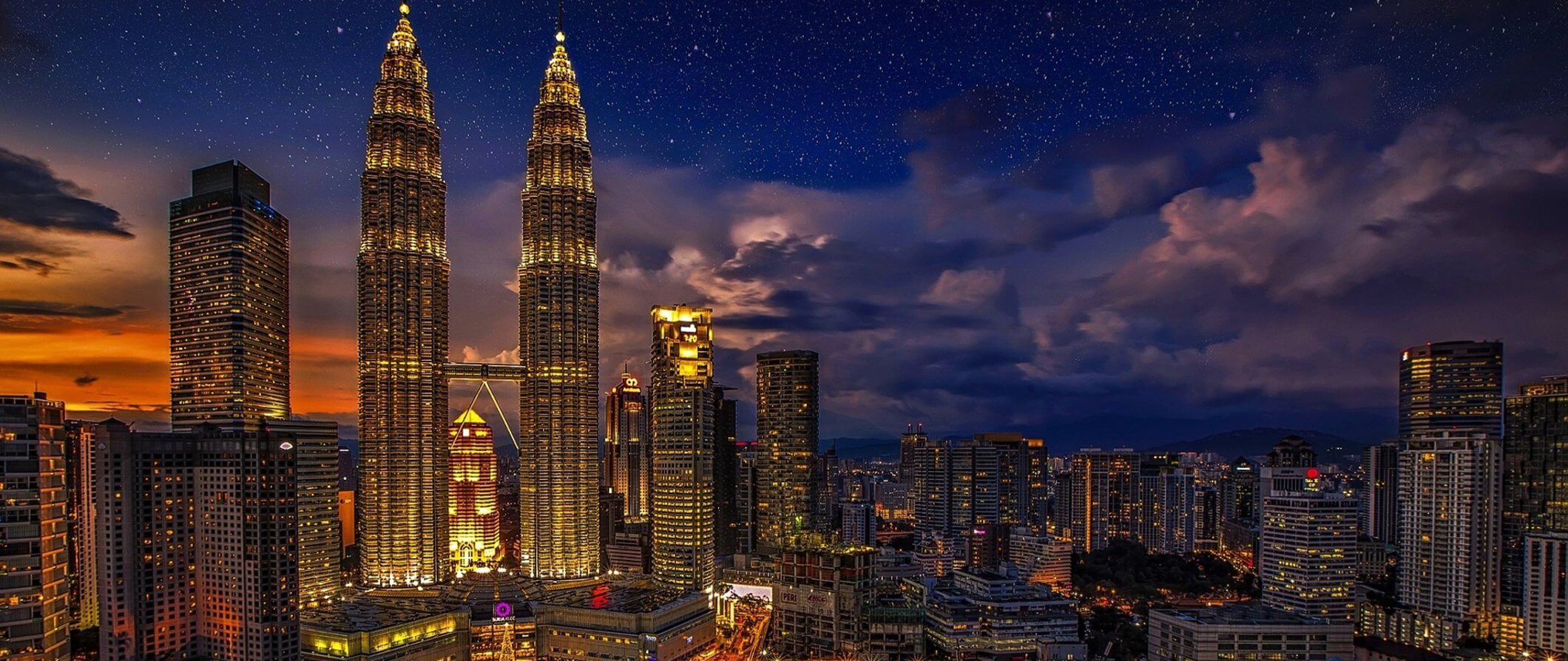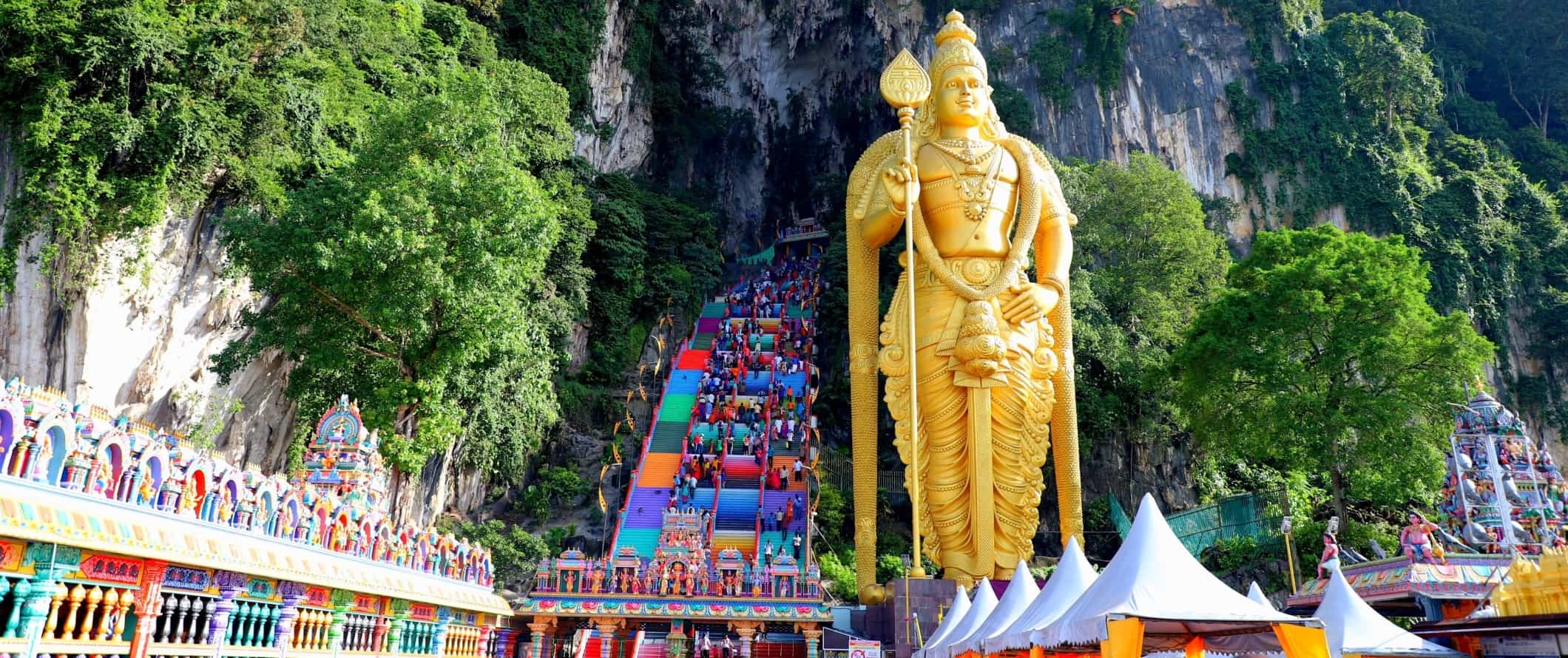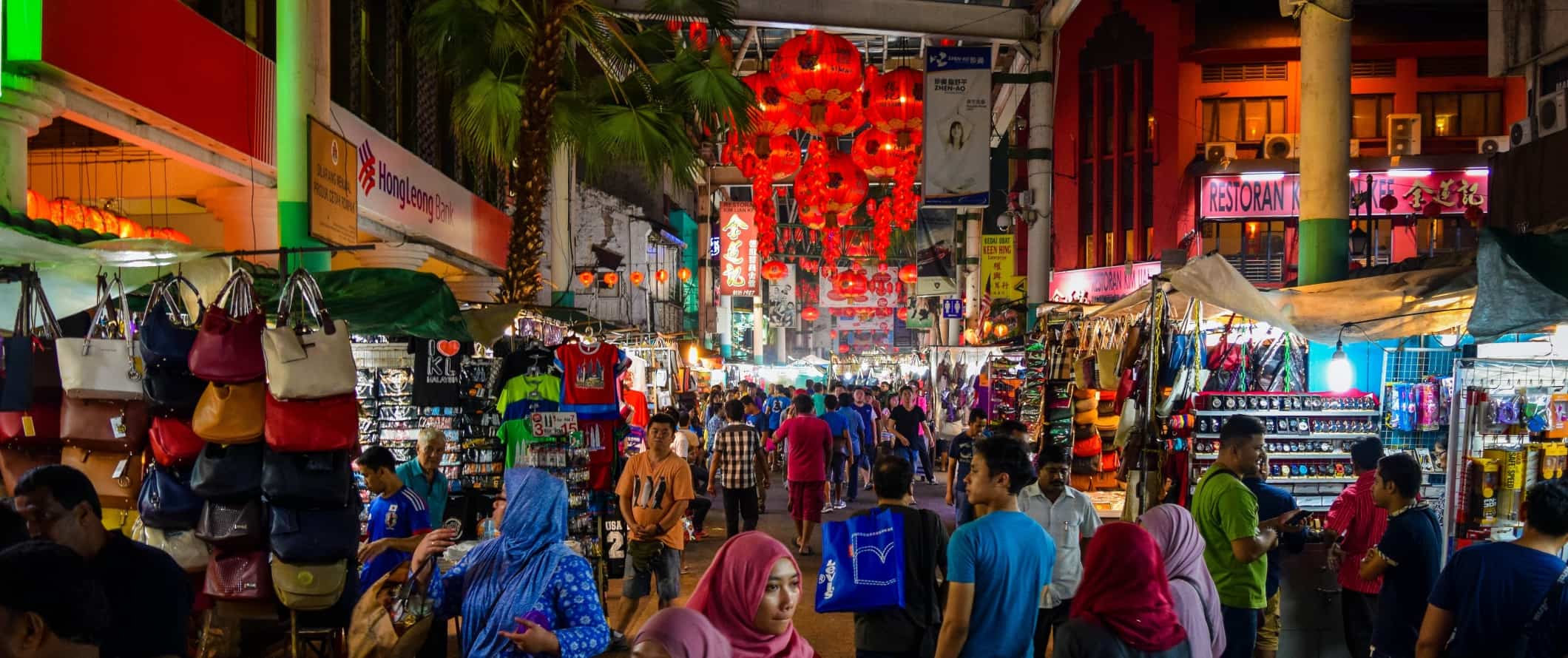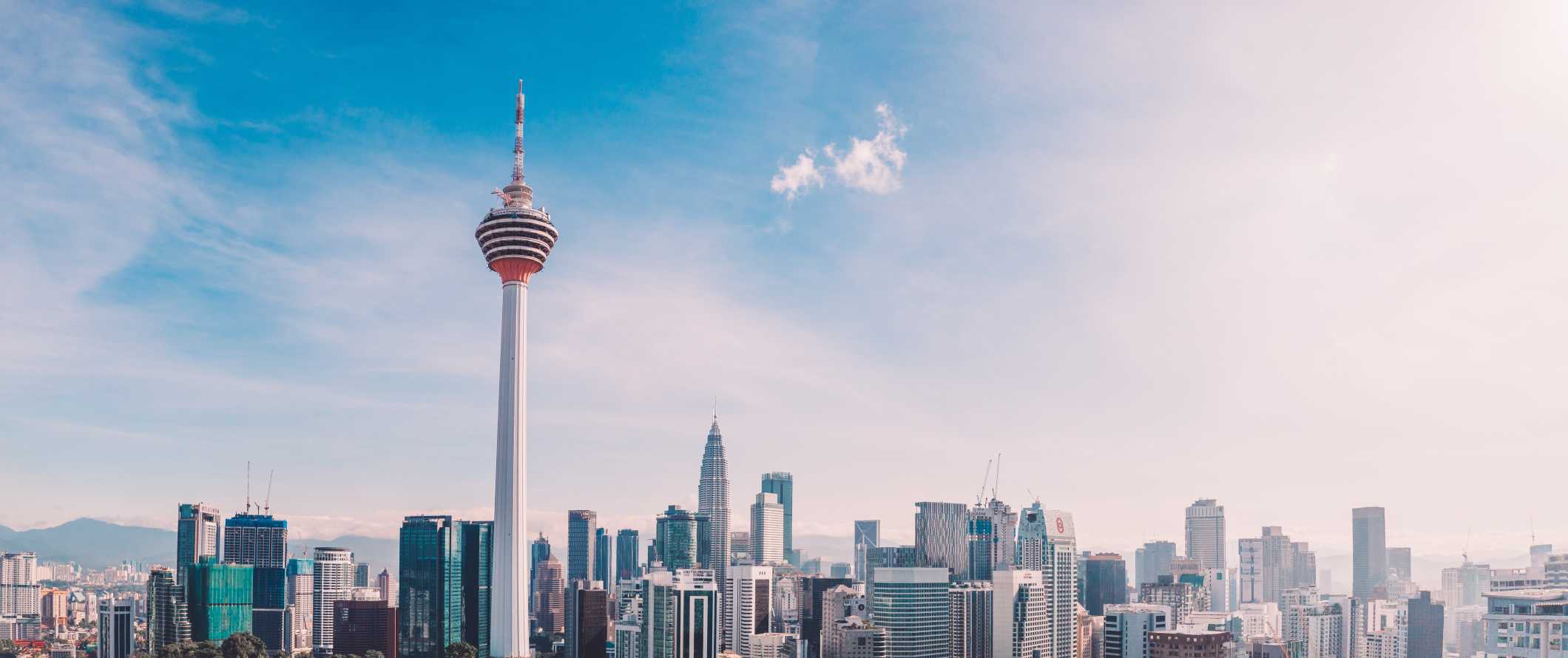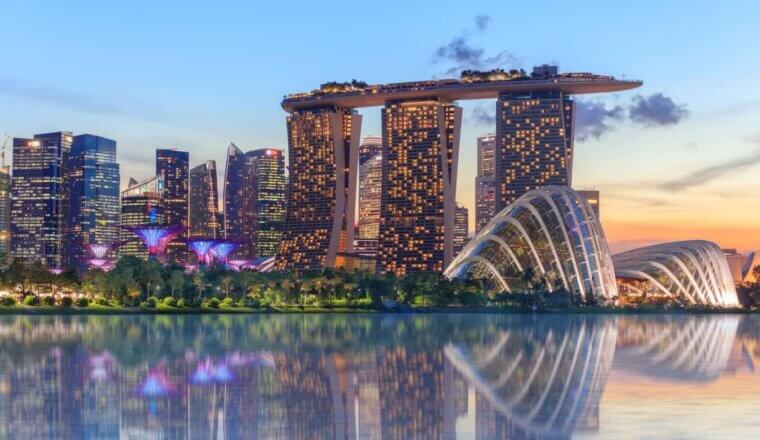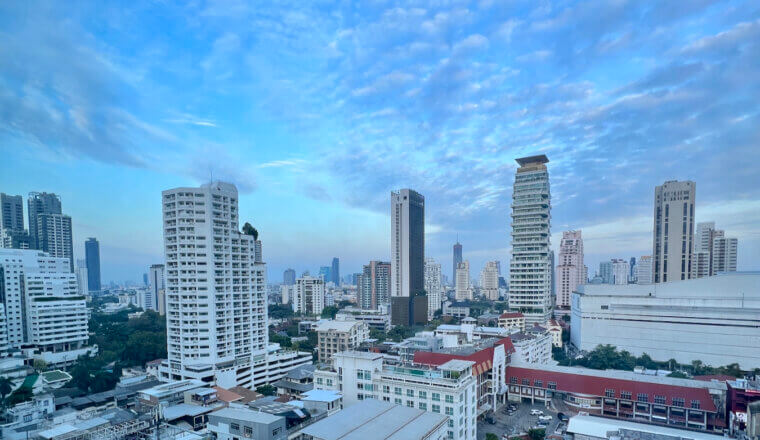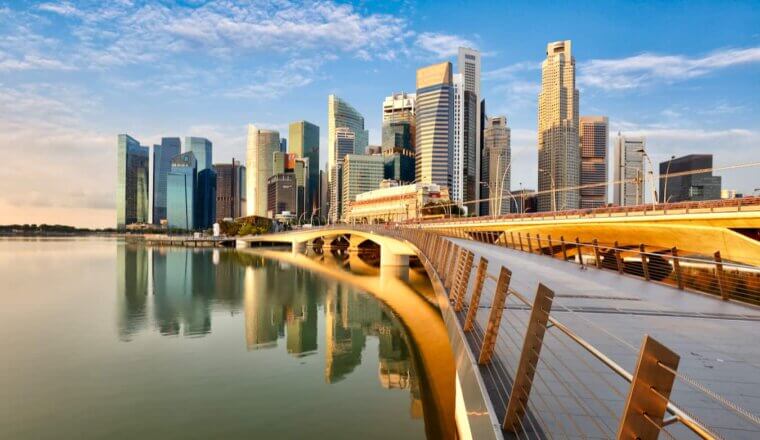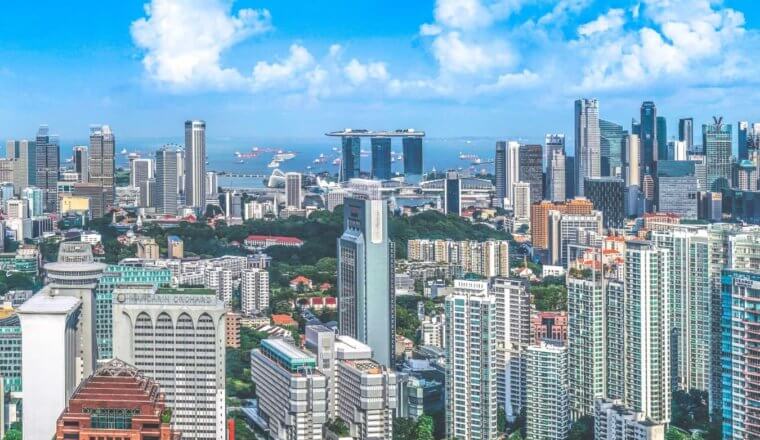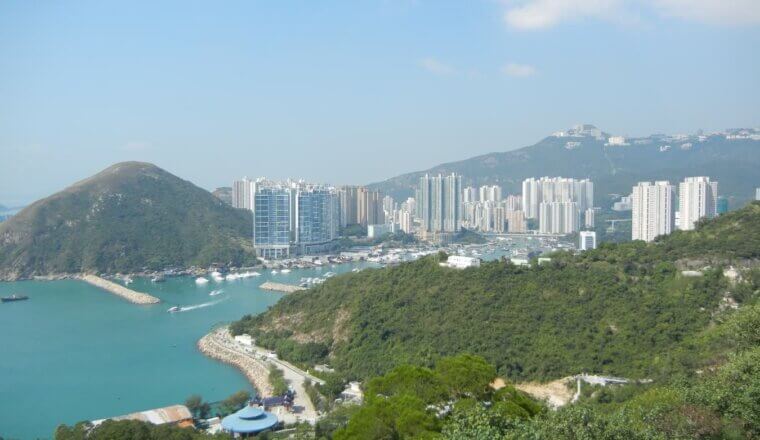Kuala Lumpur is one of my favorite cities in the world. Although more expensive than other parts of Malaysia, KL’s diverse influences creates a unique blend of food, shopping, culture, and nightlife. The city is a melting pot of Indian, Chinese, Malay, and Western influences, all of which combine to create a city like no other.
Home to some 8 million people, Kuala Lumpur is one of the best cities in the world for delicious Indian food (outside of India that is) as around 7% of the Malaysian population is Malaysian Indian. Foodies will find themselves with plenty of tasty options here, including some amazing street food.
KL is also home to the iconic Petronas Towers, the world’s tallest pair of twin buildings and a symbol of Malaysian progress and development (they were actually the tallest buildings in the world from 1998 to 2004).
This travel guide to Kuala Lumpur can help you plan an affordable and off-the-beaten-path trip to Malaysia’s most populous city!
Table of Contents
Top 5 Things to See and Do in Kuala Lumpur
1. See the Petronas Towers
These famous towers, standing over 452 meters (1,483 feet), dominate the Kuala Lumpur skyline. Visitors can take in the view from the deck on the bridge, which joins the towers on levels 41 and 42. There is only a limited number of tickets per day so arrive early. Tickets are 80 MYR.
2. Visit the Butterfly Park
The Butterfly Park is an enormous landscaped garden that’s home to over 5,000 butterflies, plants, ferns, and flowers. It also includes an insect museum that includes massive beetles and camouflaged stick insects. Tickets are 25 MYR and there’s an additional 5 MYR fee to use a video camera (tripods are not allowed).
3. Tour Thean Hou Temple
One of the oldest and largest temples in Southeast Asia, this six-tiered Buddhist temple is also known as the Temple of the Goddess of Heaven. Built in 1894 by Kuala Lumpur’s Hainanese community, Thean Hou Temple sits on a hill with sweeping views of the city. Admission is free.
4. Visit Sri Mahamariaman
Built in 1873, the Sri Mahamariaman Hindu Temple sits just at the edge of Chinatown. This is the country’s oldest and most beautifully decorated temple. The temple’s most impressive feature is the gate tower which is adorned with depictions of Hindu Gods. Admission is free.
5. Wander the Batu Caves
After climbing up 272 steps, you’ll be rewarded with the huge golden Murugan statue and the entrance to the largest of the three caves: Cathedral Cave. Once inside, you’ll be amazed at its 100-meter-high (328 feet) ceiling and ornate Hindu shrines. Admission is free.
Other Things to See and Do in Kuala Lumpur
1. Visit the National Museum
The National Museum is a great place to familiarize yourself with Malaysia’s history and culture. There are four indoor galleries that take you on a tour from the early history of Malaysia to today. The highlight is the skeleton of Perak Man, the oldest complete human skeleton found in Malaysia. It’s over 11,000 years old. The outdoor exhibit showcases transportation from over the decades, including a steam locomotive from 1921. Entrance to the museum is 5 MYR.
2. Devour the street food
Indian, Chinese, Malay, and Western foods are all common in KL. The multicultural social mix in Kuala Lumpur creates an extremely varied blend of food. The markets and roadside stalls are great places to pick up hawker food. Jalan Alor is one of the most famous streets for street food and is a great starting point; just be ready to barter. Little India and Chinatown also have lots of inexpensive food stalls serving some of the most delicious food in the city. Try the Little India Market (open daily, 8am-9pm), or Petaling Street Market in Chinatown (open daily, 8am-8pm). Chinatown’s Central Market also has plenty of tasty options too.
3. Go up Menara Kuala Lumpur
Another focal point in Kuala Lumpur’s skyline is the Menara tower. At 421-meters tall (1,380 feet), it dwarfs its surroundings and is the seventh tallest building in the world. Unlike the Petronas Towers, the floor in the Skybox is transparent so you can see through the floor down to the ground. Admission to the observation deck is 48 MYR while admission to the outside Skydeck and Skybox is 120 MYR.
4. Visit Masjid Negara
This is Malaysia’s national mosque (Islam is the country’s official religion). Set within 13 acres of garden, it has the capacity to hold 15,000 people. Its bright blue star-shaped dome represents the 13 states of Malaysia and the five pillars of Islam. Non-Muslims are welcome to visit the National Mosque outside of prayer time. Robes are given to visitors who are inappropriately dressed but try to dress respectfully before you arrive. Admission is free.
5. Wander through Lake Gardens Park
Also called the Tun Abdul Razak Heritage Park, Lake Gardens opened in 1880, making it the oldest public park in Kuala Lumpur. Located near Chinatown and the main train station, this urban park is free to visit, though it also contains various museums and gardens with paid entry. One of them is Kuala Lumpur Bird Park, one of the largest free-flight walk-in aviaries in the world, with more than 3,000 birds from approximately 200 different species. Admission is 63 MYR. Other attractions in the park include the Perdana Botanical Park, the Orchid Garden, and the Islamic Arts Museum.
6. Visit the Royal Malaysia Police Museum
This is another museum located within Lake Gardens Park. It might sound like an odd museum to check out, but it’s surprisingly interesting. The collection here features old uniforms, as well as weapons, vehicles, and items that have been seized from members of Malaysia’s organized crime families. Exhibits go all the way back to when Malaysia was under British colonial rule. It’s free to visit.
7. Celebrate Deepavali
Deepavali is the Hindu festival of lights and is one of the biggest celebrations for the Hindu community in Malaysia. It’s celebrated in October or November for five days. Also known as Diwali, Dipavali, Dewali, Deepawali, or the Festival of Lights, traditionally people host open houses with fireworks displays and serve Indian delicacies. Public celebrations can be found in the Brickfields neighborhood (aka Little India).
8. Explore the Islamic Arts Museum
The Islamic Arts Museum of Malaysia is Southeast Asia’s largest museum of Islamic art. Within this vast space is an extensive library of Islamic texts and art, as well as the world’s largest scale model of the Masjid al-Haram in Mecca (the Great Mosque of Mecca, which every Muslim is supposed to visit at least once). From jewelry and clothing to architecture and armor, spend the day exploring over 7,000 artifacts spread between 12 galleries. Admission is 25 MYR.
9. Take a food tour
If you want someone to help you explore the myriad food markets and teach you about the local food scene, take a food tour with Simply Enak. They have a variety of tours, including a walking tour through the Chow Kit market area, a nightlife tour, and a more generalized street food tour. On the street food tour, you’ll enjoy Malaysia’s most famous street food dishes, drink teh tarik (pulled tea), learn about traditional herbal medicine, and have the chance to try durian puffs — all while learning about food culture and history. Tickets cost 260-300 MYR.
10. Go on a bike tour
Cycling is on the rise in Kuala Lumpur and taking a bike tour is a great way to get a feel for the city. In operation since 2015, Mike’s Bikes is the place to go for bike tours, offering a variety of options to choose from, including the Best of Kuala Lumpur and the Pitstop Foodie Tour as well as evening sunset tours. Mike’s Bikes also gives back to the community with their Cycling School; they donate secondhand bikes to a local school for refugee children and help them upkeep their new bikes with bike maintenance classes. Tours start at 199 MYR for a 4-hour tour.
For more information on other cities in Malaysia, check out these guides:
Kuala Lumpur Travel Costs
Hostel prices – A bed in a dorm with 4-6 beds costs 35-55 MYR per night, while beds in 8-10-bed dorms cost 20-35 MYR. A private double room costs 85-125 MYR per night. Free breakfast, A/C, and Wi-Fi are all common. Most hostels rarely have kitchens so be sure to double-check if you require a place to cook your own meals. Some hostels have rooftop terraces and cafes, while several even have outdoor swimming pools.
Budget hotel prices – Budget hotels start around 75 MYR per night for a basic double room with a private bathroom, Wi-Fi, breakfast, and A/C. For a hotel with a pool, expect to pay at least 100-150 MYR per night.
Airbnb is available throughout the city, usually in serviced apartments designed specifically for travelers, starting around 95-160 MYR per night.
Food – Malaysian cuisine, like the country itself, is a mix of many cultures, taking influences from neighboring China, India, Indonesia, Thailand, and Singapore. Rice or noodles are the basis of most dishes, and seafood and fish feature prominently. As a Muslim-majority country, chicken and beef are usually halal. Commonly used vegetables include cabbage, bean sprouts, lotus root, sweet potatoes, taro, long beans, and many others.
The unofficial national dish is nasi lemak, fragrant rice cooked in coconut milk, flavored with pandan leaf, and accompanied by different sides, usually served for breakfast. Other popular Malaysian dishes include roti canai (a sweet or savory flatbread), ikan bakarlaksa (spicy noodle soup), and many different regional fried noodle and fried rice dishes.
Kuala Lumpur’s street food is legendary in both cost and flavor. You can find street food for under 10 MYR per dish, while Malay dishes in casual sit-down restaurants cost 15-20 MYR per dish. Traditional food like nasi lemak as well as various curries and dim sum are some of the cheapest options.
A fun option on a late night out is trying luk-luk. This is when you cook snacks on a stick by dipping them into boiling water or soup stock. You can cook a variety of vegetables, meat, or tofu. Prices range from 2-8 MYR per skewer.
At a mid-range restaurant with table service, a meal with a drink costs around 45 MYR. Western food is more expensive than local food but even still, a Western fast-food combo only costs around 15 MYR. At a nicer sit-down restaurant, a pizza is 30-50 MYR and a pasta dish is 40-50 MYR.
Beer at the bar shouldn’t be more than 15-17 MYR, a glass of wine starts from 28 MYR, and a cocktail is generally 35-45 MYR. An espresso at a chain like VCR costs around 12 MYR.
There are lots of high-end dining options in Kuala Lumpur if you want to splurge. Bottomless brunches with champagne and five-course tasting menus start from 450 MYR. A starter salad or soup starts at about 78 MYR while an entree like salmon or chicken starts at around 195 MYR.
A week’s worth of groceries costs 65-90 MYR, as long as you stick to local staples and avoid expensive western items (such as beef, wine, or cheese). However, given how cheap street food and local meals are and how few kitchens there are, you’re better off buying snacks and eating out for your meals.
Backpacking Kuala Lumpur Suggested Budgets
If you’re backpacking Kuala Lumpur, my suggested budget is 115 MYR per day. This budget covers staying in a hostel dorm, eating street food, taking public transit to get around, limiting your drinking, and sticking to mostly free activities like walking tours.
A mid-range budget of 295 MYR per day covers a private Airbnb or private hostel, drinking more, taking the occasional taxi to get around, eating street food and the occasional sit-down meal, and doing more paid activities like museum visits and going up the Petronas Towers.
On a “luxury” budget of 520 MYR or more per day, you can stay in a hotel with a pool, eat at restaurants for all your meals, have more drinks, take more taxis, and do whatever tours and activities you want. This is just the ground floor for luxury though. The sky is the limit!
Kuala Lumpur Travel Guide: Money-Saving Tips
Kuala Lumpur is cheap if you stick to street food, budget accommodation, and public transportation. You’ll be hard-pressed to break the bank unless you’re specifically traveling in luxury. But, just in case, here are some extra ways to save money in Kuala Lumpur:
- Shop at Lot 10 – This shopping mall sells genuine designer clothes for bargain prices, among the cheapest you are likely to find in Southeast Asia. If you want souvenirs, shop here.
- Stay in Chinatown – Chinatown is one of the cheaper neighborhoods for lodging in the city and it is relatively close to many attractions.
- Explore on foot – Chinatown and Little India are the neighborhoods with the most tourist sites. They are right next to each other and can easily be explored in a day without spending money on transportation.
- Watch out for scams – Be aware how much attractions cost before you arrive. The Batu Caves, for example, are free to enter. However, there are plenty of people outside trying to sell you fake tickets.
- Take a free walking tour – If you want to get a better feel for the city, take a free walking tour. They last a couple of hours and are a great way to engage with the city’s history and learn about the culture. Kuala Lumpur Unscripted offers two different free walks to help you get acquainted with the city. Just be sure to tip your guide at the end! For a self-guided historical tour, check out Kuala Lumpur Heritage Trail.
- Stay with a local – Couchsurfing connects you with a local who can host you for free. You’ll not only get free accommodation but you’ll get to connect with a local who can share their insider tips and advice.
- Save money on rideshares – Grab is the Malaysian version of Uber and is way cheaper than taxis. Grab is the best way to get around the city if you don’t want to wait for a bus or pay for a taxi.
- Pack a water bottle – The tap water here is generally safe (but heavily chlorinated) so bring a water bottle with you to avoid buying single-use plastic. My preferred bottle is LifeStraw, which has built-in filters to ensure your water is always clean and safe.
Where to Stay in Kuala Lumpur
Looking for a budget-friendly place to stay? Here are some of my favorite hostels in Kuala Lumpur:
How to Get Around Kuala Lumpur
Public Transportation – Kuala Lumpur has a reliable and comprehensive public transit system of buses, light rail commuter trains, and a monorail. Rides cost 2-15 MYR.
Buses in KL are generally faster than trains. RapidKL is the largest single bus network operator in Malaysia, currently running 177 routes around the city. The price depends on distance and destination, ranging between 1-5 MYR.
For 20% off fares, purchase MyRapid Touch ‘n Go, a contactless, rechargeable card that costs 5 MYR. You can load unlimited transit passes onto this card. A one-day transit pass costs 15 MYR the first time, and 5 MYR for each subsequent day pass. A three-day pass costs 25 MYR for the first time and 15 MYR for each subsequent three-day pass purchased.
Go KL City Bus is a free city bus initiative with four routes that loop through the central business district areas of Kuala Lumpur. These pass by many of the main attractions, shopping malls, and sights, running every five minutes during peak hours and every 15 minutes during off-peak hours.
Bicycle – oBike is the dockless bike-sharing system in Kuala Lumpur. It costs just 1 MYR for every 15 minutes. Simply download the app, sign up, and scan a bike’s QR code to ride.
Taxis – Taking a taxi can be tricky in KL. To start, there are two different types: the red and white Budget Taxi and the Blue or Yellow Executive taxi. For budget taxis, the base fee is 3 MYR, going up 1.25 MYR per kilometer. Executive taxis cost double.
If you do want to take a taxi, only get in ones that use a meter, which is required by law. If the driver doesn’t use the meter, get out and find one who will.
Rideshare – Grab is the Uber of Southeast Asia. Just download the app and you’re good to go.
Car rental – Car rentals can be found for as little as 85 MYR per day for a multi-day rental, though you definitely won’t need one here as public transportation goes everywhere. If you do drive, remember that traffic flows on the left.
When to Go to Kuala Lumpur
Kuala Lumpur stays hot and humid most months, making it ideal for year-round travel. On average you can expect temperatures around 34°C (93°F) during the day, and 27°C (81°F) at night.
KL is affected by two major monsoon seasons yearly and during this time certain areas face some short rainfall and thunderstorms. It does cool down after heavy rain, but the city is one of the least affected states by monsoon winds coming from the east or west. From October to January and March to April Kuala Lumpur experiences rain, so May to July is the best time to visit.
The busiest time for tourism is June through August. This also happens to be festival season, when Hari Raya Aidil Fitri and Sarawak Gawai Festival take place. Get ready for a crowd if you plan your trip during this time. Prices for hotels and flights often rise at this time of year as well.
How to Stay Safe in Kuala Lumpur
Kuala Lumpur is generally safe, but unfortunately, petty crime and scams are common so you should be always on alert. That means no walking around with your phone out, never keeping anything in your pockets (especially when on public transport), and always keeping hold of your bag.
If you are eating out, keep your backpack on your lap or place your foot or a chair leg through the straps so nobody can snatch it when you’re not paying attention.
Solo female travelers should generally feel safe here, though the standard precautions apply (never leave your drink unattended, never walk home alone at night, etc.).
For more detail on scams you might experience in Kuala Lumpur, you can read about common travel scams to avoid here.
When booking accommodation, look for hotels or hostels with 24-hour security. You always want someone around in case you need assistance. If you don’t feel safe somewhere, don’t hesitate to move on.
Use caution when getting money out by avoiding the ATMs on the street. Instead, go into the bank to use the ATM inside. That way you can put your money away discreetly without being watched.
Travelers should also note that Malaysia is a modest country, so revealing outfits attract more attention. This is especially of concern to women as groping and excessive ogling are common.
The monkeys at Batu Caves can be a bit mischievous. Do not approach monkeys quickly or give them treats. These monkeys grab anything within reach and can become quite aggressive. Protect your belongings, including keys, sunglasses, backpack, or purse. Again, don’t feed the monkeys!
Always trust your gut instinct. Make copies of your personal documents, including your passport and ID. Forward your itinerary along to loved ones so they’ll know where you are.
If you experience an emergency, dial 999 for assistance.
The most important piece of advice I can offer is to purchase good travel insurance. Travel insurance will protect you against illness, injury, theft, and cancellations. It’s comprehensive protection in case anything goes wrong. I never go on a trip without it as I’ve had to use it many times in the past. You can use the widget below to find the policy right for you:
Kuala Lumpur Travel Guide: The Best Booking Resources
These are my favorite companies to use when I travel. They consistently have the best deals, offer world-class customer service and great value, and overall, are better than their competitors. They are the companies I use the most and are always the starting point in my search for travel deals.
- Skyscanner – Skyscanner is my favorite flight search engine. They search small websites and budget airlines that larger search sites tend to miss. They are hands down the number one place to start.
- Hostelworld – This is the best hostel accommodation site out there with the largest inventory, best search interface, and widest availability.
- Agoda – Other than Hostelworld, Agoda is the best hotel accommodation site for Asia.
- Booking.com – The best all around booking site that constantly provides the cheapest and lowest rates. They have the widest selection of budget accommodation. In all my tests, they’ve always had the cheapest rates out of all the booking websites.
- Get Your Guide – Get Your Guide is a huge online marketplace for tours and excursions. They have tons of tour options available in cities all around the world, including everything from cooking classes, walking tours, street art lessons, and more!
- SafetyWing – Safety Wing offers convenient and affordable plans tailored to digital nomads and long-term travelers. They have cheap monthly plans, great customer service, and an easy-to-use claims process that makes it perfect for those on the road.
- LifeStraw – My go-to company for reusable water bottles with built-in filters so you can ensure your drinking water is always clean and safe.
- Unbound Merino – They make lightweight, durable, easy-to-clean travel clothing.
Kuala Lumpur Travel Guide: Related Articles
Want more info? Check out all the articles I’ve written on backpacking/traveling Asia and continue planning your trip:
